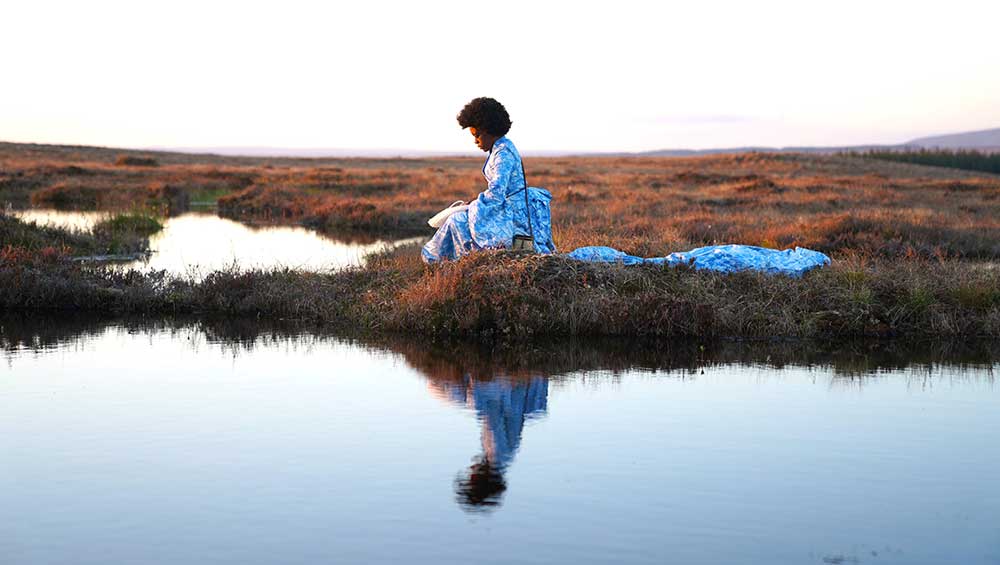
Sekai Machache, Light Divine Sky 2. Photographic print on aluminium, 2021. Image copyright the artist.
Dovecot Studios, Edinburgh (part of Edinburgh Art Festival 2023)
28 July 2023 – 6 January 2024
by BETH WILLIAMSON
You could be forgiven for thinking that an exhibition with “250 years” in its title would follow a straitened chronological path. Fortunately, Dovecot Studios, with works from the Fleming Collection, has mapped much more interesting routes through this collection. From the 1700s to the present day, the exhibition gathers together female Scottish artists significant for one reason or another. As well as a broader conversation between generations of artists, the exhibition is shaped by six more focused themes or conversations concerning inside and outside, home and away, individuals and communities. How the Dovecot refines these still quite general themes is what makes this exhibition interesting.
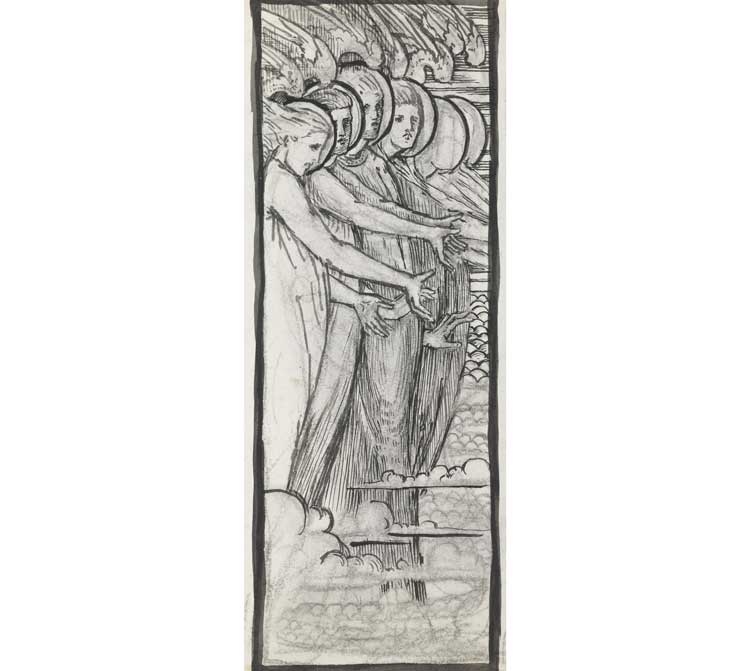
Phoebe Anna Traquair, Study for the Souls of the Blest, c1890. Ink and watercolour on paper. The Fleming Collection.
It begins with “Making her own way”, with works that represent firsts for the artists concerned. Educational and professional opportunities were historically difficult to access. In the 18th century, Catherine Read (1723-78) seized an opportunity for artistic training abroad and forged a successful career as a society portrait painter. In the 19th century, Phoebe Anna Traquair (1852-1936), an advocate of the arts and crafts movement, blurred the boundaries between fine and applied arts. As an Irish-born artist, she also represents an early instance of widening the definition of what Scottish might mean. Astonishingly, it was not until 1944 that the first woman was elected to the Royal Scottish Academy (RSA) and it was only in 2018 that Joyce W Cairns (b1947) was elected as its first female president. Formal and informal “Artistic communities” have enabled women to make their mark as artists. Art schools in Scotland provided training for women as students and employment as teachers. They also enabled access to networks, communities and resources. It was the mid-20th century before the marriage bar, which derailed the careers of these women, would be removed. Beyond the art school, other artistic communities developed – such as in St Ives and Kirkcudbright – that gave women the freedom to practise on equal footing with their male peers.
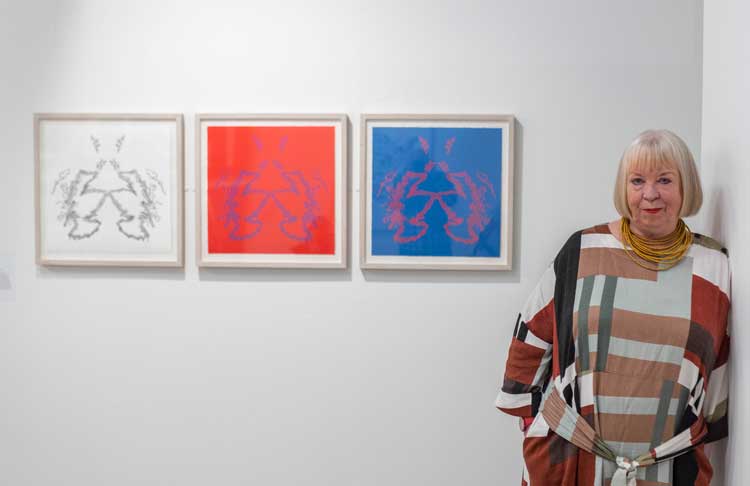
Sam Ainsley, This Land is Your Land, 2012. Photo: Phil Wilkinson.
The question of “Scottish identities”, of who belongs, is a contemporary topic, but not a new one. Whether Scottish by birth or by geography, these artists have made significant contributions to Scottish cultural life. Sam Ainsley (b1950) who was born in North Shields, trained in Leeds, Newcastle and Edinburgh, taught at Glasgow School of Art (GSA) from 1985 until she retired in 2005, and was co-founder then director of the GSA’s MFA course influencing generations of artists. Artists Flora Macdonald Reid (1860-1938) and Anne Redpath (1895-1965) moved away from Scotland (Reid to London and Redpath to France), but never lost touch with their Scottishness. In present times, Alberta Whittle, who was born in Barbados in 1980, studied at GSA and has become a hugely important figure on the Scottish art scene. Looking beyond Scotland to “Broader horizons”, this exhibition also considers the international nature of Scottish art, and the influence of other cultures can be found across a wide range of artists. In her portrait of EA Hornel, Bessie MacNicol (1869-1904) included a Japanese textile on the wall behind him. Margaret Hunter (b1948) left Glasgow to study under Georg Baselitz in Berlin, developing expressionistic techniques. Alison Watt (b1965) looked at Japanese kimonos for inspiration when designing a tapestry with Dovecot studios for Scottish Opera.
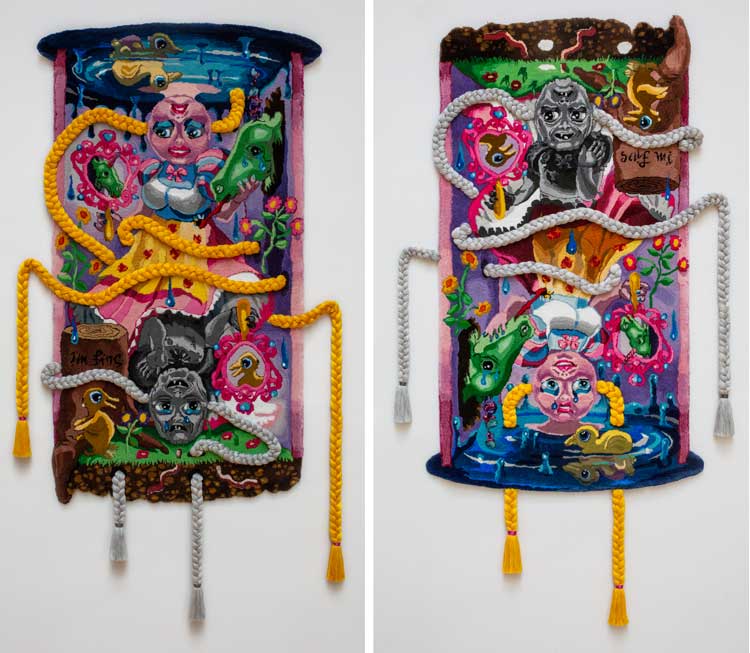
Rachel Maclean and Dovecot Studios, I'm Fine/Save Mi, 2021. Rug, gun tufted. Wool, polypropylene and canvas, 318 × 160 cm each. Tufted by Louise Trotter and Ben Hymers. Photo: Kenneth Gray.
Our “Interior lives” are another point of focus for this exhibition. Traditional tropes of woman as homemaker meant many female artists used scenes in and around the home as their subject, or looked inside themselves, an interior imagination untrammelled by social constraints. Agnes Miller Parker (1895-1980) challenged the historical conventions of the still life (think female artists and flower paintings). Her domestic cats display an air of evil and she introduced the modern element of automotive speed. In stark contrast, Rachel Maclean (b1987) delves inwards to expose and explore contemporary anxieties, make-believe and monsters.
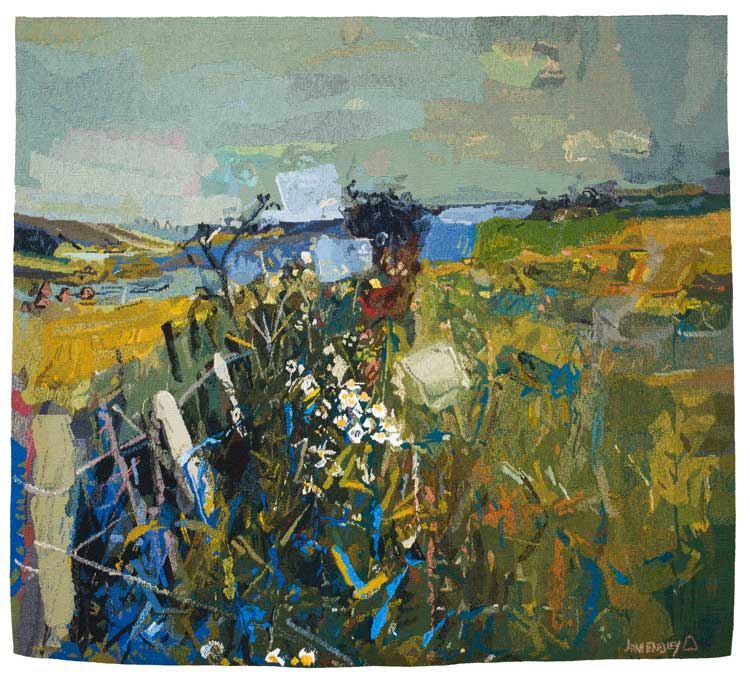
Dovecot Studios after Joan Eardley, July Fields, 2021. Tapestry, handwoven, wool and cotton, 129 × 150 cm. Woven by Naomi Robertson. Private commission. Courtesy Joan Eardley Estate. Photo: Kenneth Gray Photography.
The landscape is a long-established subject in Scottish art. In “A Scottish landscape”, the present exhibition considers how female artists across the past 250 years have addressed a traditional subject in new ways. Joan Eardley (1921-63) pushed landscape painting to new extremes in her abstract renderings of the countryside. In more contemporary work, Sekai Machache (b1989), a Zimbabwean-Scottish artist, uses landscape photography as a site to interrogate identity, colonial histories and ecological concerns. In this way, the landscape is acknowledged as the political realm it has always been.
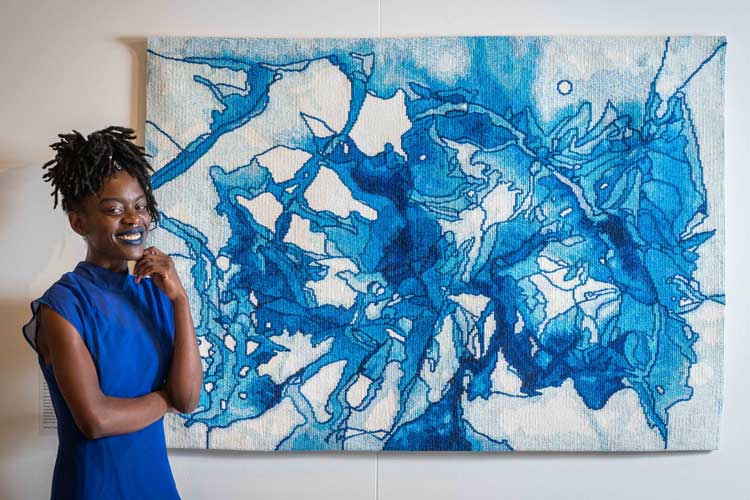
Sekai Machache, Lively Blue. Tapestry, handwoven by Dovecot weaver Ben Hymers in cotton and linen with a cotton warp. Photo: Phil Wilkinson.
What is clear in this exhibition is that female Scottish artists over the past 250 years have been equally as innovative and groundbreaking as their male counterparts, but we already knew that. What is more interesting, is a thematic hang that puts Catherine Read alongside The Glasgow Girls, or Margaret Hunter close to Alison Watt, and many more unexpected conjunctions. It is at these points of meeting that new ideas emerge and new discoveries are made. These women were not afraid to challenge preconceptions and nor should we be. Everyone can find their own connections within this exhibition, an open and productive ground for new conversations on female Scottish artists.